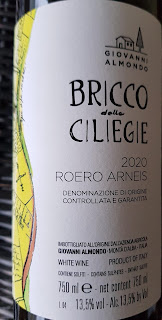A Couple of Very Highly Recommended Whites from O'Briens
Chablis and a Marlborough Sauvignon
*********
Julien Brocard Boissonneuse Chablis (AOC) 2019, 13.5%, €25.95 (was €29.95)
This biodynamic Julien Brocard Chablis “is a revelation” according to importers O’Briens: “..this is a Chablis that leaves some of the best Premier Cru in its wake.”
Colour is a clean and bright straw. Intense white fruit aromas rise to greet you. These are reinforced on the palate, the purity of the fruit (citrus and a sweet apple) with an underlying minerality, all balanced by the acidity. A rich harmony all the way to a lengthy dry finish. Indeed, it is reminiscent of a Premier Cru and no hesitation in placing this on the Very Highly Recommended list. It has been part fermented in oak foudres, part in tank to open up this structured wine.
This Chablis is so well made, so precise from start to finish, you tend to reckon it is the result of modern wine-making. Not “techie” modern though, and it looks as if the sun and moon, along with the wine-makers of course, have that precision.
Speaking of precision, I have to admit I wasn’t that precise - let’s say I wouldn’t have passed any somm exams - when opening this one and its wax closure. But these closures are quite easy to open and you can see how on this video here.
The 7 Lieux? Julien Brocard is the son of Jean Marc Brocard. In 2012 he launched his 7 Lieux range, comprising 7 wines made from plots in the family's winery in Prehy.
They say: The 7 Lieux wine was born from our desire not to exploit the earth, but let it guide us unrestrained. The soils formed during the Jurassic nourish the vines and impart a unique personality to them. The celestial cycles of the moon and sun in our northern climate give perfect maturity to the grapes. In adopting biodynamic principles, we have learned to respect this delicate union. The 7 lieu wine delivers a harmonious balance of taste and aromas as result of this intricate journey.
* Frost is a regular problem in Chablis which is somewhat isolated from the rest of the Burgundy. Indeed it is closer to Champagne that it is to the rest of Burgundy vineyard.
********
Whitehaven Sauvignon Blanc Marlborough 2021, 13%, €17.95
Pale lemon is the colour. Citrus lead the aromatics, classic for the area. On the palate, it is the turn of white peach to shine and it does, along with a supporting cast that again includes citrus. This is concentrated and elegant and not as “wild” as some NZ Sauvignons. And there’s a lingering finish.
A Very Highly Recommended Marlborough and it goes so well with goats cheese as they recommend, at least with the Ardsallagh Phantom Ash that we had handy. Other pairings they hint at are fresh seafood, summer salads and light poultry dishes.
O’Briens tell us that Whitehaven was set up by Sue White and her husband Greg. “This wine is a perennial favourite with our customers and staff alike …..is quintessentially Marlborough.”
The winemakers: The climate in Marlborough is cool Maritime, with cool summers and moderate winters. Even in the height of the summer the region experiences cool nights, which help to retain freshness and acidity in the wines.
By the way, they recommend drinking this 2021 Sauvignon Blanc while it is young and fresh, but the wine is capable of developing nicely beyond five years if carefully cellared. Serve lightly chilled






















